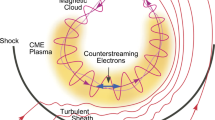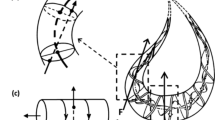Abstract
A scenario is presented whereby CMEs and interplanetary shocks are consequences of a large scale rearrangement of the coronal magnetic field induced by the disconnection of field lines from the solar surface due to the emergence of flux with opposite polarity. In this scenario the CME is the mass released from the previously closed structure and the interplanetary shock is formed by the injection of faster solar wind from an extended or newly created coronal hole which results from the opening of the field lines. Here CMEs and interplanetary shocks are associated events, but not cause-effect related. Observational and computational evidence supporting this view is provided.
Similar content being viewed by others
References
Bravo, S.: 1993,Adv. Space Res. 13(9), 371.
Bravo, S.: 1994,Geofis. Int. 33, 333.
Bravo, S. and Lanzagorta, M.: 1994, in D.N. Baker, V.O. Papitashvili, and M.J. Teague (eds.),Solar Terrestrial Energy Program, Pergamon Press, p. 227.
Bravo, S. and Pérez-Enríquez, R.: 1994,Rev. Mex. Astron. Astrofis. 38, 17.
Bravo, S. and Nikiforova, E.: 1994,Solar Phys. 151, 333.
Bravo, S. and Rivera, A.L.: 1994,Ann. Geophys. 12, 113.
Gold, T.,Gas Dynamics of Cosmic Clouds, Noth-Holland, Amsterdam, 1955.
Hewish, A. and Bravo, S.: 1986,Solar Phys. 106, 185.
Hildner, E., Gosling, J.T., Hansen, R.T., and Bohlin, J.D.: 1975,Solar Phys. 45, 363.
Illing, R.M.E. and Hundhausen, A.: 1986,J. Geophys. Res. 91, 10 951.
Levine, R.C., Altschuler, M.D., and Harvey, J.W.; 1977,J. Geophys. R. 82, 1061.
Parker, E.N.: 1961,Astrophys. J. 133, 1014.
Sheeley, Jr, N.R., Howard, R.A., Koomen, M.J., Michels, D.J., Schwenn, R. Mulhauser, K.H., and Rosenbauer, H.: 1985,J. Geophys. Res. 90, 163.
Wang, Y.M. and Sheeley Jr., N.R.: 1990,Astrophys. J. 355, 726.
Watanabe, T., Kojima, M., Ohyama, M., Tsuneta, S., Acton, L.W., Harvey, K.L., Joselyn, J.A., and Klimchuk, J.A.: 1994, in D.N. Baker, V.O. Papitashvili, and M.J. Teague (eds.),Solar Terrestrial Energy Program, Pergamon Press, p. 186.
Zhang, G.L. and Wang, C.: 1993,Adv. Space Res. 13(9), 59.
Author information
Authors and Affiliations
Rights and permissions
About this article
Cite this article
Bravo, S. Disconnection of coronal field lines due to the emergence of new photospheric flux as the cause of CMEs and interplanetary shocks. Astrophys Space Sci 243, 123–127 (1996). https://doi.org/10.1007/BF00644041
Issue Date:
DOI: https://doi.org/10.1007/BF00644041




